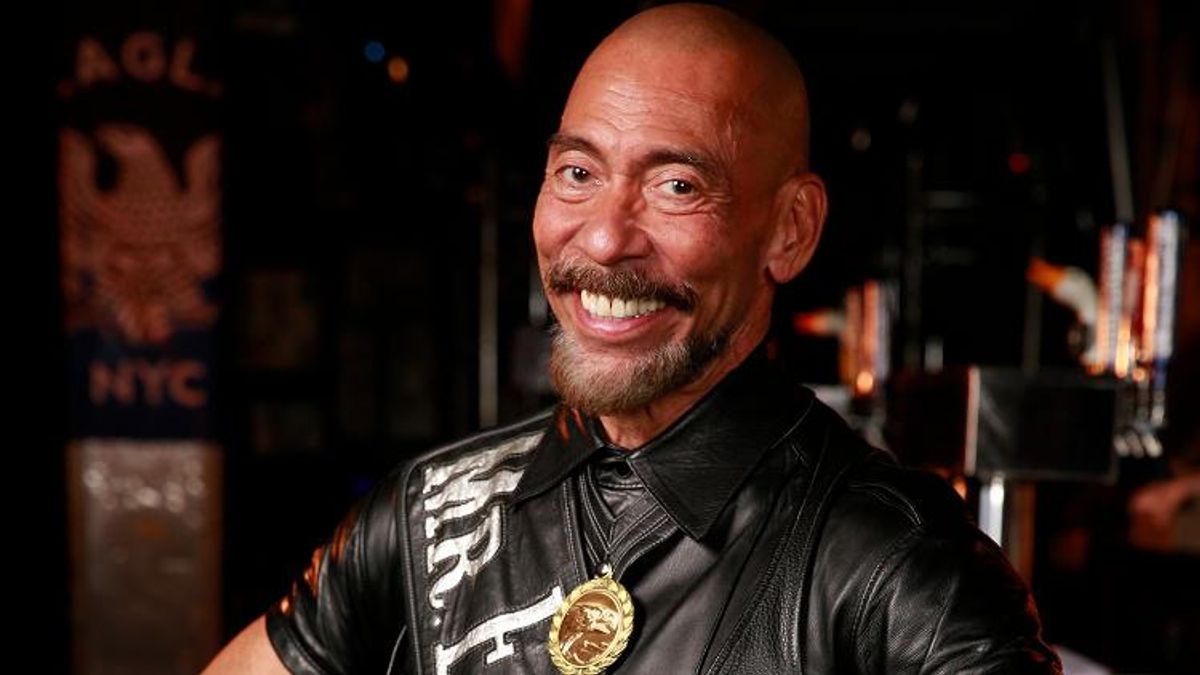For gay men who received their HIV diagnosis decades ago, aging into Social Security retirement eligibility is a marker that once seemed as unimaginable as the prospect of undetectable or untransmittable.
Strict adherence to the daily antiretroviral regimens first introduced in 1996 can itself be a burden, but long-term survivors must swallow other bitter pills as well.
Perry N. Halkitis, 57, author of Out in Time: The Public Lives of Gay Men from Stonewall to the Queer Generation believes, “For older adults living with HIV, antiretrovirals bestow, potentially, a level of comfort with one’s [ability to transmit HIV].”
The fear of transmitting HIV to one’s partner is now history for those who are able to reduce their viral loads to the point that they can no longer pass the virus to others.
Still, Halkitis, who was diagnosed with AIDS in 1988 but is now currently undetectable, notes that for long-term survivors like himself, “An underlying trauma exists. The alienation, stigma, and loss associated with the epidemic is particularly pronounced, given they expected to die.”
Halkitis — dean, professor and director at Center for Health, Identity, Behavior and Prevention Studies, Rutgers School of Public Health — contributes to an emerging field of study dedicated to people with HIV and AIDS over 50.
That population is growing. As documented by the Centers for Disease Control and Prevention, “we can say that as of 2017, 50 percent of all PLWHA [people living with HIV/AIDS in the U.S.] were 50 and older,” explains Stephen Karpiak, PhD, senior director for research at the ACRIA Center on HIV and Aging at New York City’s Gay Men’s Health Crisis. Although the data isn’t in yet, Karpiak says that as of this year that stat is expected to hit 55 percent nationally, and 62 percent in New York City.
Longevity was an unlikely prospect when Reverend Steve Pieters, 67, was diagnosed first, in 1982, with what health professionals at the time called Gay-Related Immunodeficiency; and later, in 1984, with two AIDS-related cancers.

“When they pronounced me ‘terminal’ in 1984, that’s when I began to think I wouldn’t live to see 1985,” Pieters (shown above) recalls now. He spent 39 weeks that year in a clinical trial for Suramin, one of the first medications investigated as a potential HIV treatment. Most of the men in the trial did not survive.
Many of the men Pieters had sex with during that era later died of AIDS-related illnesses. He recalls two muscled partners with whom he says enjoying mutual masturbation, “contributed to my becoming sexual again” after his diagnosis.
They later proceeded to “protected oral and anal sex” using condoms. Pieters laments now, “I have to wonder if the condoms slipped or I didn’t do everything I should have.” Both men passed away from AIDS-related conditions, although he doesn’t know if they got HIV from him.
“Of course, there’s some level of survivor’s guilt. But I hope that my activism and my ministry [as Staff Clergy at Los Angeles’s Founders Metropolitan Community Church] have been a tribute to all those friends who died.”
Grieving for friends as well as the loss of his own youth and vitality, Pieters says he occasionally succumbs “to my tendency toward depression,” but feels, with age, “I’ve acquired much more effective ways of dealing with it. I don’t sink as deeply, and it doesn’t last as long.”
Pieters finds support through his church, gym, the HIV service organization APLA Health, and sharing his story at public events, as a member of the Gay Men’s Chorus of Los Angeles, where many younger members regard him as “a tribal elder.”
“I think a lot of that has to do with their awareness of all I survived in the worst of the ‘plague years,’” Pieters says, appreciative of their acknowledgement. “There are [other] times when I feel I’ve entered ‘the age of invisibility,’” he adds. “Sometimes, when I walk into a room full of younger gay men I may not know, it feels as if no one even notices me.”
Living with HIV since the ’80s did give Pieters what he calls “an early start on developing coping skills that others might not have, because my long-term HIV infection and its treatments have sped up the aging process.”
Since his early 50s, Pieters has developed high cholesterol and triglycerides, coronary artery disease, arthritis, stenosis of the spine, neuropathy, cataracts, glaucoma, and problems with balance. Still, the 67-year-old is currently undetectable and considers himself “pretty healthy for a man who’s had GRID/AIDS for decades.”
But he admits, one or more of the 30 drugs in his medical regimen has rendered him impotent, leading to a 2003 decision to lead a celibate life.
“I could be joyfully sexual again, with the aid of Viagra or Cialis, if I fell in love and wanted to have a relationship,” explains Pieters. “But I’m not out looking for it. I am so much happier than I ever was when I was sexually active. I miss the intimacy, but I don’t dwell on that.”
 Thom Kam learned of his positive status in 1992. Now 64 and currently undetectable, he is “very certain” he actually seroconverted in 1987. “That puts me at 33 years living with HIV, and for 24 years on antiretroviral therapy,” says Kam, who recalls feeling “devastated” when he was told he was undetectable.
Thom Kam learned of his positive status in 1992. Now 64 and currently undetectable, he is “very certain” he actually seroconverted in 1987. “That puts me at 33 years living with HIV, and for 24 years on antiretroviral therapy,” says Kam, who recalls feeling “devastated” when he was told he was undetectable.
“I realized that I was going to survive, when so many others hadn’t. This was, and is, the hardest thing for me, about surviving,” Kam explains. “I think a lot about the countless friends I lost to AIDS. I do feel cheated, thinking that my life would have been richer if we had more time together for those friendships to have become deeper, as friendships do through the decades.”
That weight, says Kam, “seems to have become a bit lighter, as I start acknowledging that most of my years are behind me.”
But he’s not dead yet, nor are his desires. When his 14-year committed relationship ended in 2000, recalls Kam, “I found myself gravitating toward men who were HIV-positive, and taking care of themselves.”
That changed, he says, “about two years ago.” That’s when the wider adoption of PrEP and his own undetectable status first made him feel “more comfortable being with guys who are negative.”
Kam is transparent about his HIV status with new sexual partners and gets tested for other sexually transmittable infections every quarter — as is recommended for all of those on PrEP. “So, I feel fairly safe with them, regarding HIV and other [STIs],” he says.
Still, “hooking up is a low priority,” Kam says. He’s also experienced discrimination on dating apps.
“What surprises me,” he says, “is encountering guys my age and Gen X-ers, that are interested in HIV-negative partners only. The self-loathing, stigma, and irrational fear that represents in 2020 makes me feel really sorry for them. I’m delighted and encouraged to see that it’s a nonissue for the majority of millennials.”
A member of the leather community, Kam, was crowned Mr. Eagle NYC 2019, and says that although it’s “segmented and not unified,” there is still a community “code of responsibility, whether you’re negative or positive, that I’m very proud of.”
Gregg Bruckno, 49, is program coordinator of GMHC’s Terry Brenneis Hub for Long-Term Survivors, launched in June 2018 to provide resources and build support networks for those in need. Bruckno says that workshops and social programming, in partnership with St. John’s Lutheran Church, allow attendees to “connect socially, so it’s not all about the dating apps. And if it turns out to be love, then we become matchmakers.”
Bruckno, diagnosed HIV-positive in 1999 and currently undetectable, is sexually active, but was married (2001-2015) when “dating apps came out.”
Now, he says, “There’s more openness about it on apps, but there is still a stigma. If you have it on your profile, maybe they’ll shame you. So I tell people when we meet.”
For many long-term survivors though, there’s still a fear of being rejected for having HIV, Bruckno acknowledges, “that is almost the same as it was back in the day.”
But he says, “If you have the confidence to convey [it], I would say being undetectable can be a good marketing tool for having sex.”


 Thom Kam learned of his positive status in 1992. Now 64 and currently undetectable, he is “very certain” he actually seroconverted in 1987. “That puts me at 33 years living with HIV, and for 24 years on antiretroviral therapy,” says Kam, who recalls feeling “devastated” when he was told he was undetectable.
Thom Kam learned of his positive status in 1992. Now 64 and currently undetectable, he is “very certain” he actually seroconverted in 1987. “That puts me at 33 years living with HIV, and for 24 years on antiretroviral therapy,” says Kam, who recalls feeling “devastated” when he was told he was undetectable.










































































